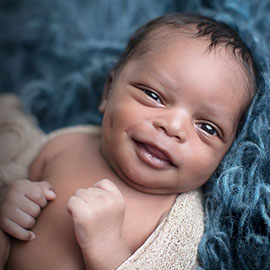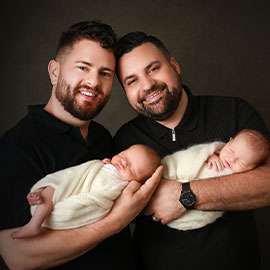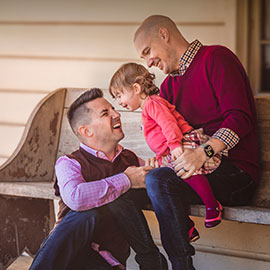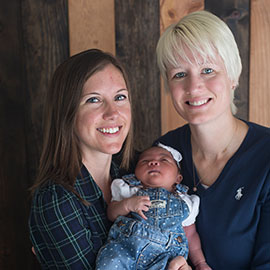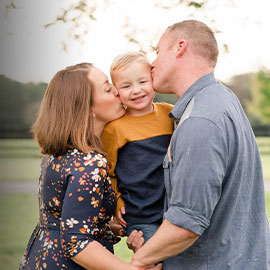What is Open Adoption?
There are many different types of adoption, but open adoption is the most widely practiced type across the United States. Why is it so common? While there are pros and cons to every type of adoption, open adoption can be the most beneficial to both birth and hopeful parents of all backgrounds. It’s also one of the most varied types of adoption, as no two open adoptions look alike. While each one may look different, the term “open adoption” generally refers to an adoption in which the following two things happen:
-

Identifying information, such as names, phone numbers, email addresses, and more, is shared between adoptive parents and birthparents.
-

Communication between both parties is established before, during, or after the adoption process. Communication between birth and adoptive parents can be over the phone, in person, or even through an intermediary.
Ultimately, how these two factors take shape can vary greatly. Depending on the agreement between birth and adoptive parents, communication in one open adoption can look vastly different than communication in another. That means that the answer to “What is open adoption?” is unique and changes on a case-by-case basis.
Your Adoption Journey Begins With LifeLong Adoptions
Since 2011, we’ve successfully connected hopeful families of all different backgrounds and types with birth parents. As one of the first service providers of LGBTQ+ adoptions, we attribute our success to both our expert-level services and our commitment to making lifelong dreams of parenthood come true for everyone, regardless of marital status, religion, race, gender, sexual orientation, ethnicity, disability, or otherwise. We’re strong believers in inclusivity, and our helpful team is dedicated to assisting and providing guidance to single parents, couples, throuples, and adoptive families of all other types. In other words, we’re committed to helping you grow your family.
Complete Our Free Adoption Application
How Does an Open Adoption Work?
Step 1: Be Open About Your Wishes With Your Adoption Coordinator
After completing our free adoption application, a coordinator will reach out to get more information and prepare you for the next steps. Our coordinator will ask what type of adoption you’d like, explaining the differences between open, semi-open, and closed. Most adoptive families choose some level of open adoption, defining what type of communication they’re comfortable with. As a rule of thumb, the more open and flexible you are willing to be, the larger number of expectant mothers your adoptive family profile may be shown to.
Step 2: An Expectant Mother Expresses Interest in Learning More About You
Based on the information you’ve provided, and after the creation of an adoptive family profile and the completion of an adoption home study, expectant mothers will be able to learn more about your family. Your coordinator will share your adoptive family profile with expectant mothers who share similar values and levels of openness. Then, an expectant mother will choose to connect with you, and your adoption coordinator will help arrange some form of communication (it could be a phone call, text, or email).
Step 3: Building Communication and a Relationship
This is the part of the process where the differences between open adoptions really take shape. After contact has been established, some adoptive parents and expectant mothers can choose to continue to communicate and build a relationship, while other connections may experience limited communication. It all depends on the comfort level and desires of each party, and experiences could range from semi-regular texts or phone calls to multiple in-person visits.
Step 4: The Post-Placement Open Adoption Agreement
It’s not uncommon for expectant mothers to change what type of open adoption they’re interested in throughout the process of communicating with adoptive parents. Leading up to the birth of the baby, expectant mothers reserve the right to adjust what they’re looking for or change their minds. As a result, this could change what the open adoption looks like when the baby goes home with the adoptive family. This is why a post-placement agreement is important, as it can help outline expectations and clearly express wishes between birth and adoptive parents. A birthmother may ask for occasional updates via text or email, or she may express interest in regular video chats or an in-person visit.

"Every day we realize how fortunate we are that our adoption journey was so quick and so seamless. We are truly blessed to have these two beautiful girls join our family."
- Allen & Jill
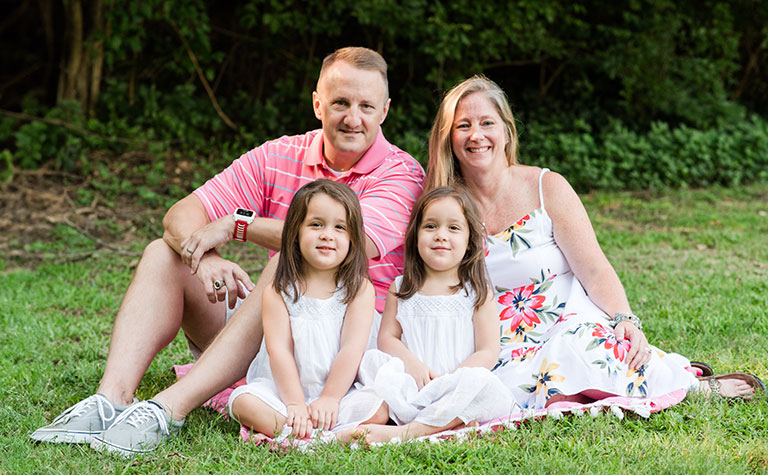
Benefits of Open Adoption
The uniqueness and ever-evolving possibility of what an open adoption looks like may seem stressful to some hopeful parents. However, there are many benefits of open adoption that enrich and positively impact the lives of adoptive family members, adopted children, and birthparents equally. Consider these benefits:
-

Open adoption allows for more access to important health and background information.
-

By communicating with adoptive parents, expectant mothers are able to better understand that the selfless and difficult decision they made in choosing adoption ended up being a great decision for themselves, their children, and hopeful parents.
-

In many open adoptions, birthmothers and adoptive parents build strong, supportive, and wonderful relationships that benefit both parties.
-

As adopted children grow and learn more about themselves, they inevitably have questions about their biological families. Open adoption allows for access to that information as well as communication with biological family members.
-

Children of open adoptions have a better opportunity to learn about themselves, their background, and who they are, thus building a stronger sense of self.
Grow Your Family With Us
Open Adoption vs. Co-Parenting: What’s the Difference?
Open adoptions take many forms, and with how different each adoptive family’s experience is, it’s not unusual for parents to express concern or incorrectly confuse co-parenting for open adoption. Legally speaking, open adoption and co-parenting are very different, and in cases of open adoption, after the adoption has been finalized, all legal rights and guardianship of a child belong exclusively to the adoptive parents.
What is Co-Parenting?
Co-parenting is when two or more parents, who are not married or in a relationship, legally share responsibility for raising a child. In these situations, each party has to share responsibility and work with each other to care for and raise the child.
With Open Adoption, You Won’t Have to Worry
After an open adoption is finalized, birthparents terminate their legal responsibility and guardianship for their child. Depending on the agreement made between the adoptive legal guardians and the birthparents, birthparents may ask for updates via cards or letters, some form of communication, or the possibility of a visit. While adoptive parents are expected to honor the post-placement agreement, it doesn’t mean birthparents can take back a child, nor does it open the door for co-parenting. Legally speaking, guardianship and responsibility for a child belong only to the adoptive family.
Does Open Adoption Confuse Kids?
One of the concerns some people may have about open adoption is whether or not this type of communication or relationship between biological parents and adoptive parents may confuse children. Simply put, the answer is no. Open adoption isn’t confusing for children, and if handled appropriately and honestly, adopted children can more easily understand their story and build stronger senses of identity.
Below, we’ve put together some helpful tips on how to approach the topic of open adoption with children. This list can be especially helpful for adoptive parents who are in semi-regular contact or communication with the birthmother of their adopted child.
-

Create healthy dialogues around the topic of adoption: Though some may express concern over young children learning about adoption, no evidence suggests that this is true. Creating healthy dialogues and normalizing discussions about adoption can help young children conceptualize who they are and where they came from. It can also help clearly define adoptive and biological families, especially when adoptive parents establish specific terms and language, such as “birthmom” or “birthparents” to help establish distinct roles.
-

Honesty and Openness are Key: Adopted children will often have a lot of questions about who they are and where they came from. It’s recommended that adoptive parents answer these questions head-on, being open and honest with age-appropriate details. This helps build and maintain trust, and it also helps children better understand their story.
-

Use Positive Language: When establishing roles and discussing the differences between birth and adopted parents, positive language is essential. It avoids implanting negative thoughts or feelings about a child’s birthparents, and it helps prevent any self-confidence issues that may arise from ascribing negative language to any aspect of a child’s background. Ultimately, positive language is key in helping children grow and establishing stronger senses of self.
-

Keep photos, letters, cards, and more on display: If biological families have sent letters, photos, gifts, or other items, keeping them on display or somewhere visible can help normalize open adoption. These kinds of things can serve as reminders of a child’s story, as well as spark conversations that lead to helpful discussions. Plus, leaving these items out in the open reinforces the positive aspects of adoption, encouraging children to better understand who they are and where they came from.
We're Always Here to Help
At LifeLong Adoptions, we understand that adopting a baby is a long, complicated, and ultimately rewarding journey. Throughout the process, there are many different choices that have to be made, and sometimes it can be overwhelming. Our helpful team of compassionate coordinators is always here to offer guidance and help in any way that they can. Please contact us with any questions about adoption, and let us assist in making your lifelong dreams of parenthood come true.


